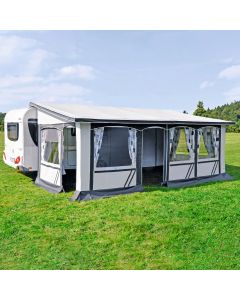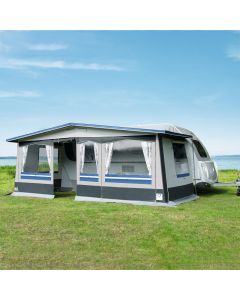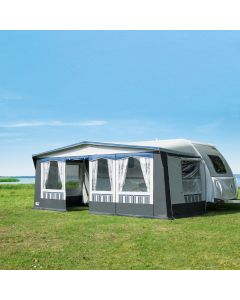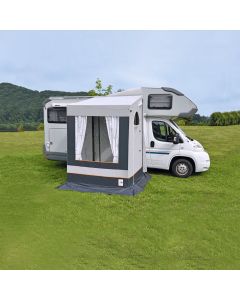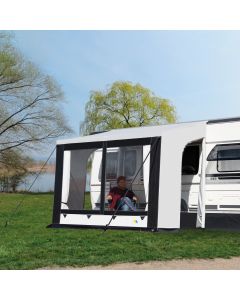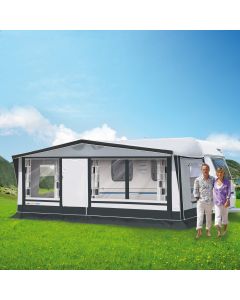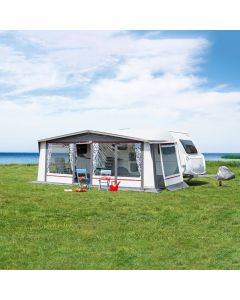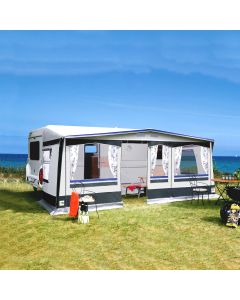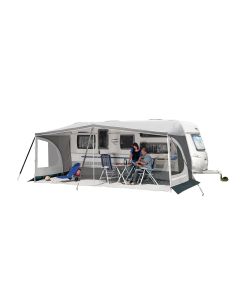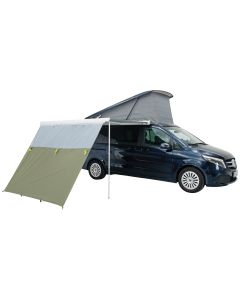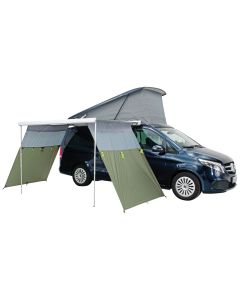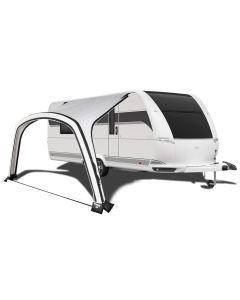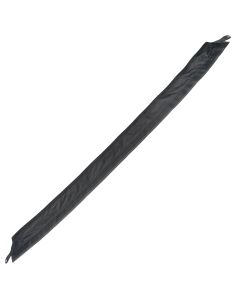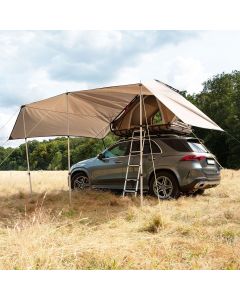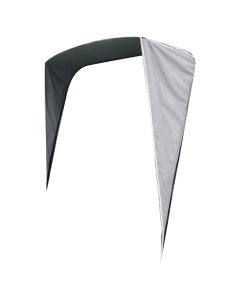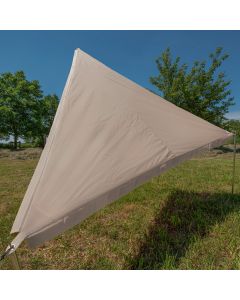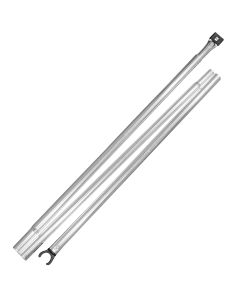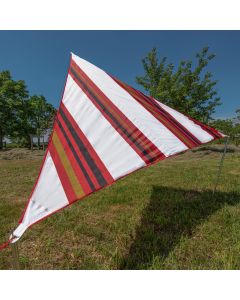An awning that is pulled in along the entire length of your caravan is suitable for travelling as well as seasonal and permanent camping and significantly increases your living space. To connect the awning to the caravan, the piping (attached to the awning) is pulled into the existing piping rail on the caravan. Because they are time-consuming to set up, it is recommended to use such an awning for longer stays. Spontaneous campers who perhaps only want to spend a few days at a campsite should opt for a so-called travel awning instead.
The difference between travel awnings, seasonal/all-season awnings and partial tents
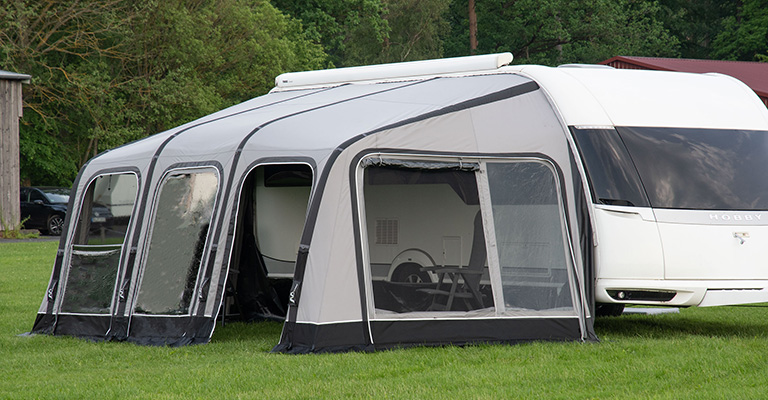

Travel awnings
The classic travel awning is suitable for short holiday trips and not for long-term use. Travel awnings are light and easy to pitch. They also have a small pack size and weight.
UV radiation and extreme weather conditions place increasingly high demands on materials and features. Therefore, good sun protection is the be-all and end-all of a good awning.
Covered zips are tighter and last longer, while taped roof seams seal the awning reliably. Both quality features are definitely worth it.
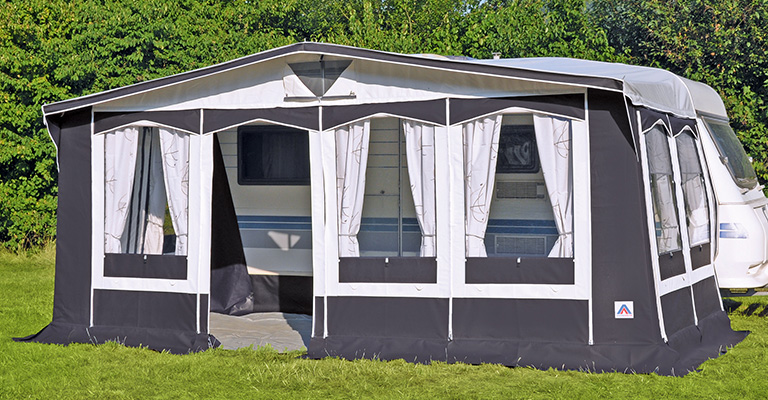

Seasonal and all-season awnings
Seasonal and all-season awnings are probably the most elaborate types of awnings. They use PVC-coated material on both sides. The material has to be more tear- and abrasion-resistant, so that it can be used for all-season camping. Condensation occurs both with material coated on one side and on both sides. However, fabric that is only coated on one side absorbs moisture. Therefore, only fabric coated on both sides is suitable for long-term use.
Awnings for seasonal or year-round use are usually equipped with additional features, such as double draught skirts and window flaps. Due to the use of robust materials, these awnings have a higher weight and a larger pack size.
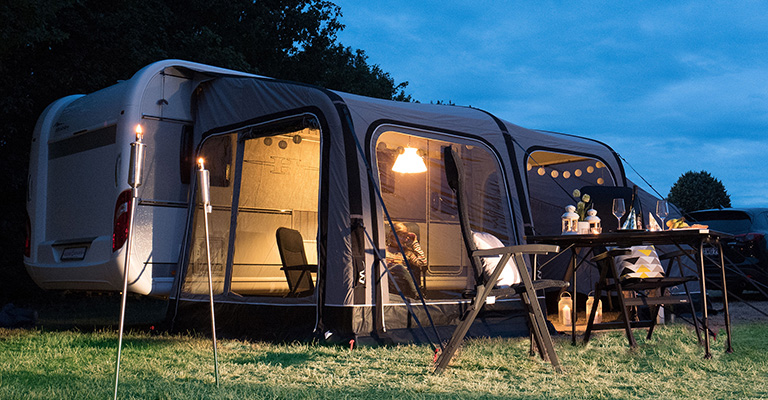

Partial tents for caravans
Partial awnings do not cover the entire length of the caravan. This makes them independent of the circumference of the caravan. They are initially set up like larger tents.
However, with a partial tent, you are much more flexible, as it fits on different vehicles and can be attached centrally as well as on the right or left. Please keep in mind that windows and openings are not covered.
Since they are quickly set up, partial tents are especially suitable for short trips and for winter camping. Winter campers also benefit from the low tent depth, as snow can easily slide down the resulting steeper roof surface.
Useful things to know about awnings
Extra space thanks to sleeping cabins!
With the optional inner tent, you quickly and easily create a sleeping area in your freestanding awning. It is easily attached with hooks and sleeps up to two people. Perfect for guests, children who want more privacy or anyone who prefers to sleep outside.
What is the veranda effect?
If the windows and doors of the front wall of your awning can be folded down completely, you can achieve a veranda effect. It lets you enjoy fresh air and warm sunlight in your awning. Veranda poles are usually available as accessories.
Distance to the ground – draught skirt
The distance from the lower edge of the fabric to the ground can vary from caravan to caravan and depending on the ground conditions. The draught skirt should be at least high enough to allow the tensioning rubbers to be stretched. The rest of the draught skirt rests on the ground. The groundsheet and the carpet can then be laid on top of it.
The right poles!
Pole types: air tubes, steel, aluminium, fibreglass.
For roof poles, you need awning eyelets, some of which still have to be fitted to the vehicle wall. Some awnings are pre-equipped with a second piping for attaching these eyelets, so that they do not have to be attached to the vehicle.
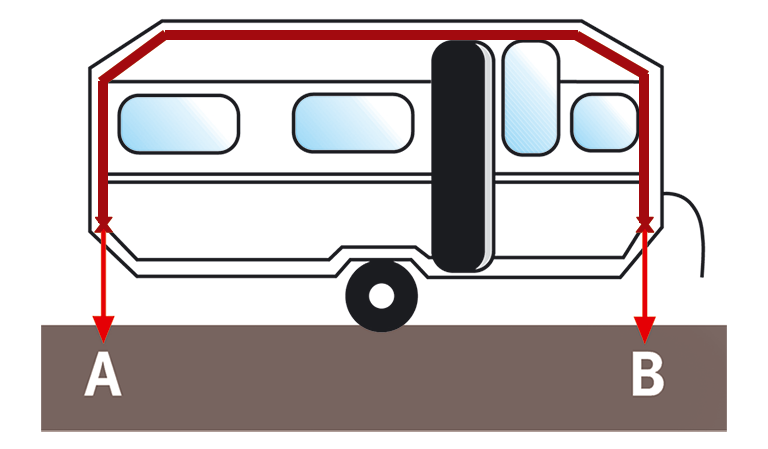

Pick your own awning size!
Measure the circumference of your caravan on a level surface when the vehicle is stationary by passing a cord (A) through the piping strip back to the ground (B).
You can then use the measured circumference to find the right awning size for your caravan, motorhome or van.
How is the awning attached?
There is usually a piping rail on the vehicle. The piping on the awning is pulled into this aluminium or plastic profile. Piping rails can also be retrofitted and look like a "C" in cross-section. The bead or piping is inserted into the piping rail. There is also a piping rail at the bottom of the awning to horizontally attach the windbreak or the mud flap. This means that this side of the awning can also be closed to make it windproof.
Inserting the awning into the piping rail
First check your rail for sharp edges! To ensure that the piping slides into the rail more easily, we recommend spraying it with our draw-in spray ZipFit (item no. 450/305). Of course, the awning should be secured with the guy ropes often supplied as well as with pegs. A storm strap set also gives the awning stability when it storms. In most cases, the awnings are already fitted with the corresponding fixtures so that the appropriate storm strap set can be easily attached.
Awnings from the Frankana Freiko Collection
Rear tents and van/motorhome awnings
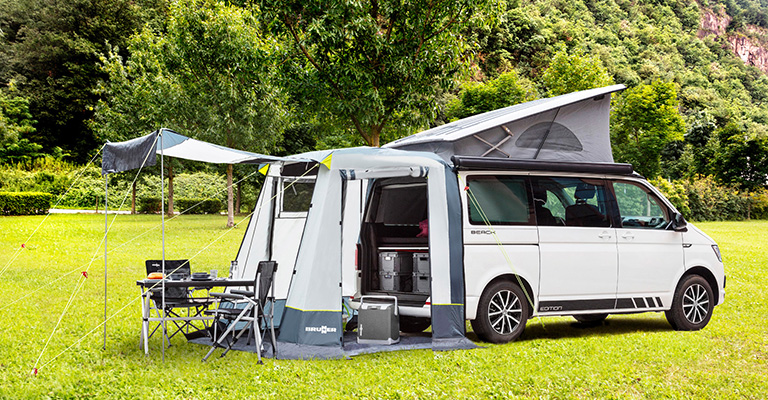

Rear tents for vans
With a rear tent, you gain a lot of usable space with headroom directly next to your vehicle. Use it for showering, changing, cooking or sleeping or simply for storing your bicycles. The ideal solution for all those who need extra space quickly or who only have limited space next to or behind their vehicle at the campsite.
Freestanding rear tents are perfect if you want to leave the campsite with your van. Many other rear tents are attached directly to the vehicle (usually to the tailgate) without poles.
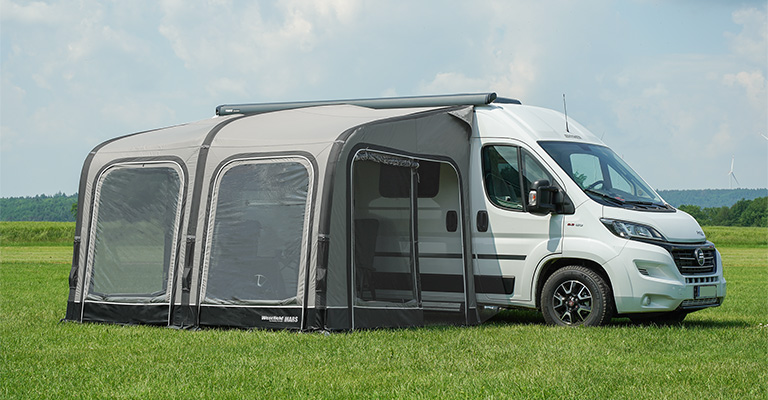

Van and motorhome awnings
Van awnings are suitable for beginners. Usually without a fixed groundsheet and with a low hydrostatic head, they are ideal for your summer holiday. A modern solution is offered by van awnings with air tubes and an inner groundsheet. With their high hydrostatic head and good ventilation, they are also ideal for use in autumn, at the seaside or in northern holiday destinations.
Most van awnings are freestanding and provide the option of retracting a rear wall so that the van awning can be completely closed. This means you can explore your holiday destination in your vehicle during the day and leave your camping equipment in your van awning at the campsite.
Sun canopies
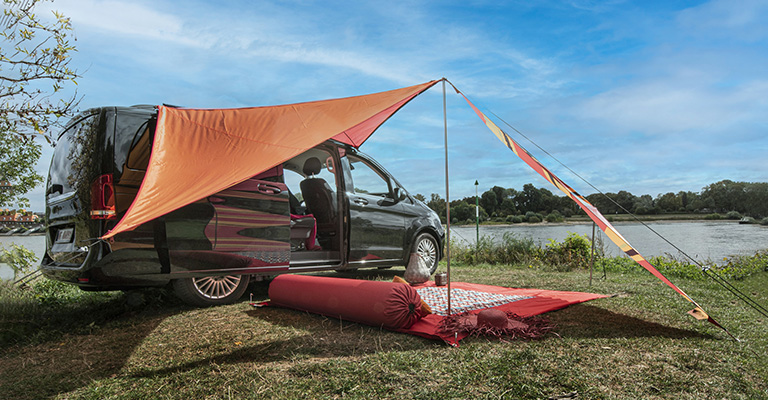

Sun canopies are ideal for camping trips. They are usually easy to assemble with only a few poles. Thanks to the material and design, they can be used in a variety of ways – for example, there are pure sun canopies that are extremely light but offer no protection against rain.
Sun canopies can be fitted partially or to the entire length of the vehicle. They can be extended with side walls or a front wall.
High-quality canopies offer protection from both wind and rain. The canopy can be fitted wherever there is a piping rail – not just on the side of the entrance. Vario models fit on vehicles and can also be attached to existing awnings. Here, you can place matching eyelets on the roof for the awning poles.
How to attach your awning to your van
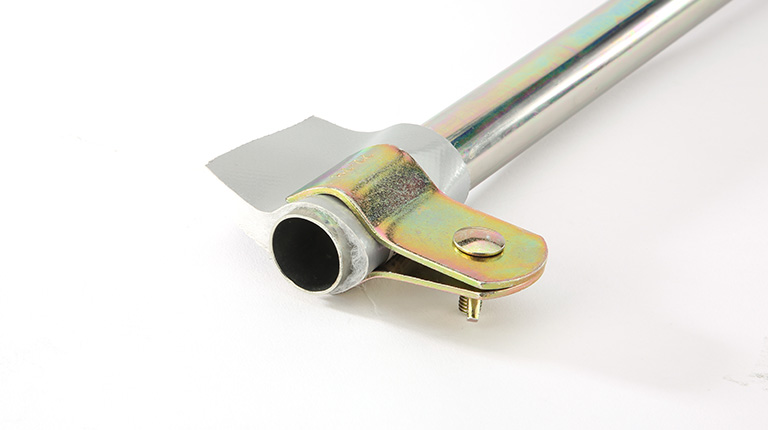

1. Standard mounting (with rain gutter):
Insert the connecting pole into the hemstitch of the spacer strip. Insert into gutter and fix with clamp.
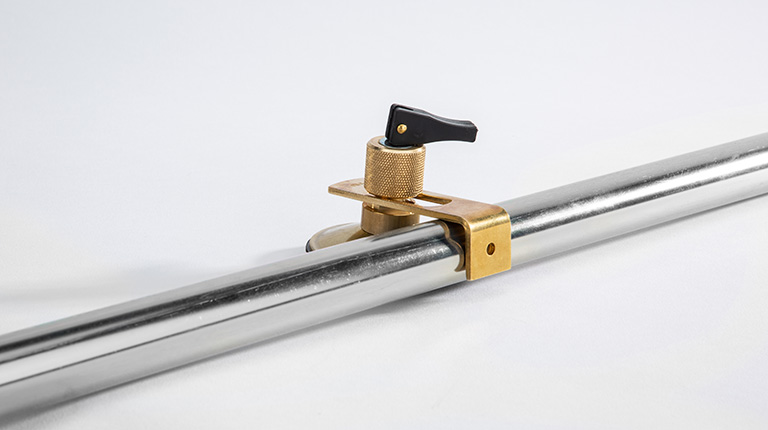

2. Mounting without rain gutter:
Clamp the connecting pole to the clamping suction cup. Attach the connecting pole to the roof of the vehicle.
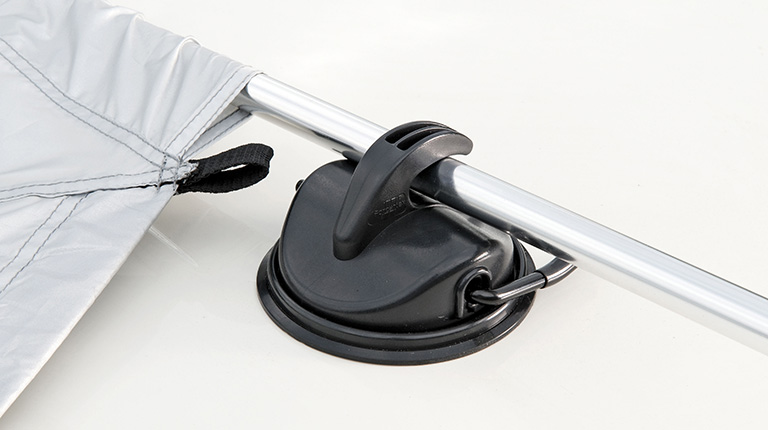

3. Fixing suction cups:
Simply clamp the connecting pole to the suction cup. Paint-friendly attachment.
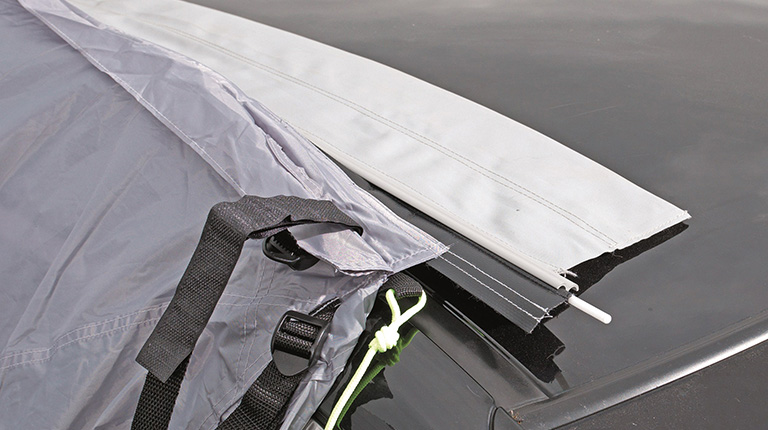

4. Mounting with piping:
With the piping magnetic adapter set. Is connected to the tent with piping and profiles and adheres to flat vehicle roofs.




